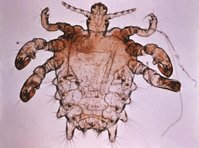You Say You Itch Somewhere? Body lice (Pediculus humanus corporis) and public lice (Phthirus pubis) are pesky parasites closely related to the head louse.
Fortunately, the body louse is relatively rare in this country. It thrives in unsanitary, overcrowded living conditions and historically has been common in military, refugee and concentration camps, prisons, and overcrowded city dwellings. It can carry organisms that cause disease such as epidemic typhoid fever. This criter lives and deposits its eggs in clothes, bedding, and other personal articles and then hops aboard a human when it needs a feed.
The body louse has figured in a number of history's main events. The story goes that after Archbishop Thomas Becket was assassinated at Canterbury Cathedral in 1170, the penitential hair shirt he never removed was found to be swarming with lice. The term "cootie" is said to have originated in the trenches of Work War I as a nickname for the body louse that was all-too-familiar to so many of the soldiers.
Body lice usually go their own way when living conditions are improved. Thus, today, they are a rarity in most developed areas of the world.
Public lice are transmitted by close - usually sexual - contact. Also called crab lice, or simply "crabs," public lice seen close up resemble a crab, with two grasping "arms" in front. They live on the human body where the hair is coarse - mostly in the pubic area and armpits. The infested area frequently becomes itchy and, as with head lice, a rash often results. Like head lice nits, the whitish eggs of the pubic louse are firmly attached to the hair shaft. The lice may look like small scabby crusts, or they may appear as small bluish spots on the skin. Sometimes infested people may notice louse excretion - minute brown specks - on their underwear.
Along with other sexually transmitted diseases (STDs), "crabs" seems to be enjoying a resurgence, especially among those in their teens and 20s. Therefore, people who find they have pubic lice would be wise to be examined for other STDs.
The same products that get rid of head lice will also do away with crab lice.
COPYRIGHT 1990 Pediatrics for Parents, Inc.
COPYRIGHT 2004 Gale Group



